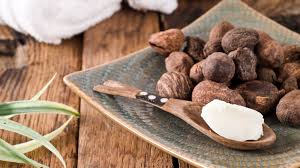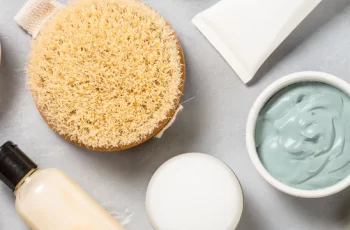
Shea Butter in Skin Care
Shea butter is the extracted fat of the Butyrospermum Parkii plant native to sub-Saharan Africa. (9)
It has been used in regional holistic medical practices for centuries in across Africa for its anti-inflammatory and soothing properties. (1,4)
Shea butter is known for its moisturizing fatty acids, rich antioxidants, and ability to soften scar tissue.
The kernels of the tree are roasted, then mashed with water before being filtered and cooled for cosmetic use. (6)
Read below to find out all about shea butter in skin care!
Be sure to take the Baumann Skin Type quiz for free to make sure you only buy the most suitable products for your skin!
What is shea butter?
Shea butter is called “butter” because of its thick, smooth, creamy feel. It is an oil.
It has a creamy texture because it is primarily composed of saturated fatty acids.
It is a plant based oil, but it is too thick to be considered an essential oil.
Instead, it is considered a carrier oil, used in fragrances and cosmetics as a base for other ingredients to bind to.
Shea butter has hydrating, soothing qualities because it also contains many unsaturated fatty acids like oleic and linoleic acids.
It is not a mineral oil even though it is good at protecting from UV; mineral oils are derived from petroleum, not plants.
Here are some of my favorite products with shea butter:
What are the active compounds?
Shea kernels are mostly made of fats, it is rich in beneficial fatty acids like: (in order of concentration)
Stearic
Oleic
Linoleic
Palmitic
Arachidic
Besides fatty acids, shea butter is rich in antioxidant phenolic compounds like quercetin, trans-cinnamic acid, and dozens of other compounds, many of which are also found in green teas.
The specific phenolic composition of shea butter varies based on the region the kernel was harvested, among other variables like weather. (3) (natural, plant based ingredients always have compound variability.)
The most common active antioxidant phenolic compound in shea butter is gallic acid. (3)
Studies have found that the pulp of the shea fruit contains a very appreciable amount of vitamin C. (6)
Vitamin C (ascorbic acid) is a known effective antioxidant ingredient skin care, and contributes to the antimicrobial qualities of shea butter.
The concentration of compounds can also vary drastically between processed and unprocessed shea butters.
Refined vs raw shea butter
Refined vs unrefined shea butter
Unrefined shea butter is thick, yellow, and has a similar texture to dairy butter.
Unrefined shea butter is very comedogenic, but is extremely rich in beneficial, hydrating fatty acids and antioxidants.
Refined shea butter is repeatedly boiled or roasted, and pressed into a slightly more fluid, and much whiter product than unrefined shea butter.
As might be evident from the loss of color, there are fewer active compounds in refined shea butter, but it is less comedogenic.
Either form of shea butter can be used in skin care based on the particular skin condition a product is designed to treat.
Refined shea butter, for example, can be safer in acne treatments, while unrefined shea butter can be better in treating dry skin conditions.
Handmade vs machine processed
Unrefined shea butter still undergoes some processing to get from kernel to cream.
Without the help of machinery, shea butter can actually deteriorate in quality if processed too slowly.(11)
For that reason, processed shea butter often has a higher concentration of beneficial compounds than unprocessed shea butter.
Synthetic chemicals are not typically used in the processing of shea butter, meaning none of the natural compounds are destroyed chemically.
Shea kernels undergoing “by-hand” processing are more likely to denature over time in the elements.
Since machine processing results in less time between harvesting the kernel to finished oil, it is actually the preferred method of production for skin care quality shea butter.
Benefits of shea butter
Benefits
There are many interesting benefits associated with the active compounds in shea butter, such as antimicrobial, moisturizing, UV protecting, and keloid treating qualities.(2)
Stearic acid, the most common fatty acid in shea butter, is great in barrier repair moisturizers and helps prevent trans-epidermal water loss. Although shea butter has oleic acid that creates tiny perforations in the skin, the fact that it has more stearic acid than oleic acid makes it a superior barrier repair oil for the treatment of eczema and dry skin.
It is also a soothing oil because it contains anti-inflammatory compounds like linoleic acid.
Antioxidant phenolic compounds provide antiaging benefits. These phenolic compounds give products a longer shelf life by preventing oxidation of lipids.
Some studies have even found shea butter to be anti-carcinogenic, meaning it might help treat and prevent some kinds of cancer. (4) That being said, more evidence based testing is always needed on cancer treatments.
Side effects
Shea butter is comedogenic, meaning it has a chance of clogging the pores of acne-prone skin.
It also contains a high concentration of oleic acid, which some dry skin types find irritating on the skin, but this is counteracted by the even higher amount of stearic acid.
If you are sensitive to oleic acid, you might experience mild inflammation on applied areas.
Is it safe?
Shea butter is a safe ingredient in skin care.
The EWG safety rating for shea butter is “1,” which means there are no common concerns associated with use of shea butter in skin care.
If you are pregnant (or a baby), shea butter is considered non-toxic and safe for use as well.
The only hazard associated with using shea butter is that it is a tree nut.
If you have a tree nut allergy, consult your allergist or primary care physician about whether shea butter is safe for you.
Shea butter is considered a clean ingredient.
Is shea butter safe?
Uses
Shea butter is increasingly popular every year in skin care products as more research comes out to support its significant hydrating and antioxidant properties.
It can be found in a number of products targeted towards dry skin care, hair care, stretch mark prevention creams, and sun protection.
Acne
Shea butter contains comedogenic fatty acids, meaning it can clog the pores of sensitive skin types.
Shea butter is not the best oil to choose when you have acne-prone skin.
There is also a notable concentration of oleic acid in shea butter, which helps other ingredients permeate into the skin which can increase the risk of irritation from acne medications like retinoids and benzoyl peroxide. If you are particularly prone to acne and worried about comedogenic ingredients, here are some of the best acne treatments for you to consider.
Dry skin
Shea butter can be found in dozens of moisturizers designed for dry skin because of its occlusive and hydrating properties.
It has about 1/3 the effectiveness of mineral oils in preventing TEWL and serving as an effective emollient for eczema(8) but it is still considered a good ingredient to treat dry skin.
It is anti-inflammatory, which means it soothes redness or irritation.
Even though shea butter contains oleic acid which is often irritating on extremely dry skin, its other active compounds negate those effects in many cases.
To be sure shea butter is right for your dry skin treatments, take our questionnaire and shop by your Baumann Skin Type!
Take the Quiz
Hair care
The fatty acids and antioxidants in shea butter are very healthy for hair follicles and strands.
Shea butter is a creamy, heavier oil so it should be used in modest applications to avoid weighing down your natural hair texture.
It has a similar texture to coconut oil.
It is a comedogenic product, so if you are prone to acne on your hairline, shea butter might not be right for your hair.
Hyperpigmentation
Shea butter is largely composed of unsaturated fatty acids and antioxidant compounds, but it does not treat dark spots.
Because it also contains saturated fatty acids, which promote melanin production, it can actually contribute to hyperpigmentation in some cases.
While it may not be great for treating hyperpigmentation, it is a good ingredient at absorbing UV radiation.
There are better oils than shea butter to use in moisturizers to lighten dark spots.
Wrinkles
Shea butter contains tons of antioxidant properties that are hugely beneficial in many anti-aging regimens.
Vitamin C is present in the pulp of shea butter (6), which is a common additive to anti-aging products.
Used alongside other anti-aging ingredients like retinoids, shea butter can be an effective part of many wrinkle treating products.
This ingredient absorbs UV radiation from the sun, which means it helps prevent light-based skin aging, but should always be combined with SPF.
Thanks for checking out this blog on shea butter in skin care! To find out if shea butter is right for your skin type, take the Baumann Skin Type quiz for free today by clicking the button below!


